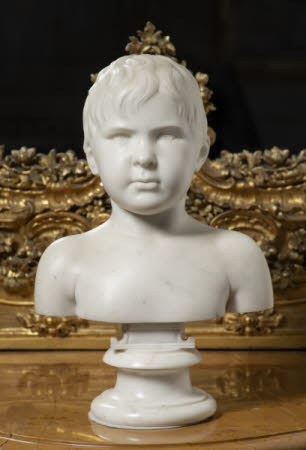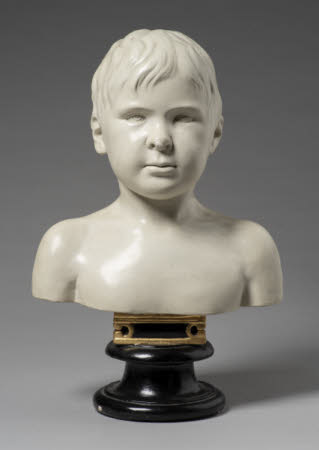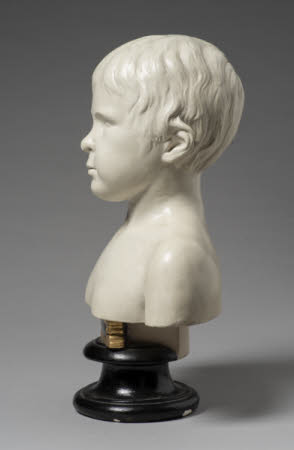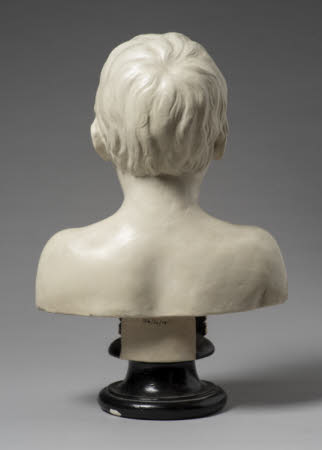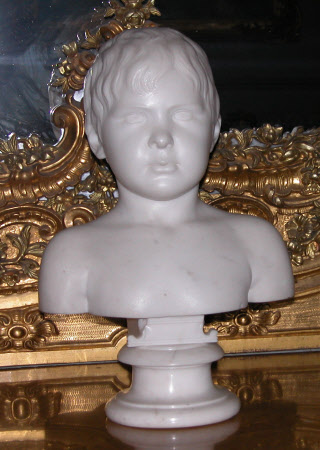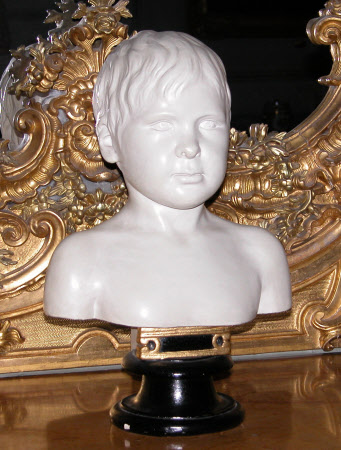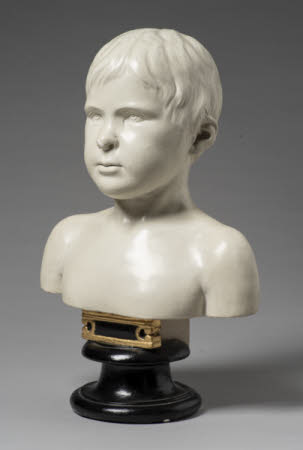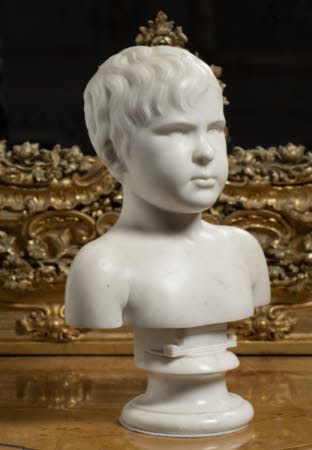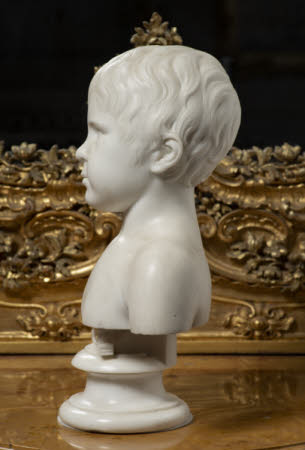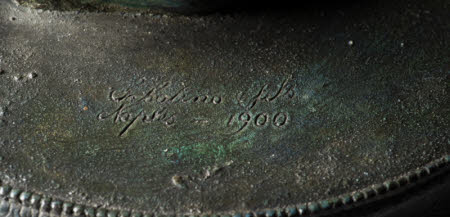Portrait of Frederick William Hervey, later 2nd Marquess of Bristol (1800-1864), as an infant
Elizabeth Boughton, Lady Templetown (1747 - 1823)
Category
Art / Sculpture
Date
c. 1802 - 1804
Materials
Marble
Measurements
46 x 30 cm
Place of origin
London
Order this imageCollection
Ickworth, Suffolk
NT 852217
Summary
Sculpture, marble; Portrait bust of Frederick William Hervey, later 2nd Marquess of Bristol (1800-1864),as a small child; Elizabeth Upton, Lady Templetown (1747-1823); London, c. 1802-04. One of three busts at Ickworth depicting Frederick William Hervey and his elder sister Augusta when they were very small children, sculpted by their grandmother Elizabeth Upton, Lady Templetown, a talented amateur artist who is best-known today for the designs she supplied to Josiah Wedgwood. .
Full description
A marble portrait bust of Frederick William Hervey, later 2nd Marquess of Bristol (1800-1864), depicting the sitter at the age of around two or three. He is shown bare chested, facing frontally and with a determined expression on his face. The bust is slightly angled back. Mounted on a circular socle with a tablet. This is one of three remarkable portrait busts at Ickworth, sculpted by Elizabeth Upton, Lady Templetown (1747-1823), depicting the two eldest of her grandchildren at very early stages in their lives. Elizabeth Upton was one of a small group of well-born women living in the second half of the eighteenth century who were able, to varying degrees, to make use of their considerable artistic talents by pursuing careers as amateur artists. Others included Diana, Lady Beauclerk (1734-1808) and the Honourable Anne Seymour Damer (1748–1828). Like Diana Beauclerk, Elizabeth Upton is best known today for the designs she made from 1783 for Josiah Wedgwood and delivered in the form of paper cut-outs, which were then modelled up in the factory and reproduced on Wedgwood wares (Hughes 1952). Born into a gentry family in Herefordshire, in 1769 Elizabeth Boughton married Clotworthy Upton (1721-85), a courtier who in 1776 was created Baron Templetown of Templetown, Co. Antrim and who died in 1785, leaving Elizabeth a widow with a son and three daughters. Some of the couple’s wealth may have derived from slavery; Lord Templetown owned estates and enslaved people on Grenada which, on his death in 1785, he bequeathed in trust for his wife for life, although her later life does not appear to have been a very wealthy one. The only sculptures by Elizabeth Upton currently known are all at Ickworth, but she seems to have begun to sculpt from an early age. In 1773 she travelled with her husband to Italy, where they remained until 1775. The sculptor Richard Hayward recorded the couple in Rome in 1774, noting that ‘Mrs Upton models in Clay and wax’ (Stainton 1983, p. 15). The Uptons must have come to know Giovanni Battista Piranesi (1720-78), who in dedicating to Elizabeth Upton a plate of his great compilation ‘Vasi, candelabri, cippi, sarcofagi, tripodi, lucerne ed ornamenti antichi’, published in 1778, was fulsome in his praise for her learning: ‘To Mrs Eliza Upton, English Lady and most learned in every conceivable field of the liberal arts’ (‘Alla Signora Eliza Upton Dama Inglese Intendentissima in ogni sorta di Arti Liberali’). Accompanied by her three daughters, Elizabeth Upton returned to Italy as a widow late in 1792, remaining for the next three years. In February 1798 her youngest daughter Elizabeth Albana Upton (1775-1844) married Frederick William Hervey, later 5th Earl and 1st Marquess of Bristol (1769-1859). Their first child, Lady Augusta Hervey (1798-1800), was born on 8 September 1798. Her grandmother the elder Elizabeth Upton, Lady Templetown, made a fine portrait of Augusta at the age of about one year old, an excellent study of early childhood (NT 852216). The portrait of Augusta’s brother Frederick William Hervey shows him perhaps a little older, around two or three. The version in plaster (NT 852217.2) would have been made first and used as the model, from which this marble portrait (NT 852217.1) would then have been worked up. In making these sculptures of her grandchildren, the sculptor demonstrated her awareness of both older and contemporary prototypes. She must have known examples of the charming busts of small children made by the Florentine sculptor Desiderio da Settignano (c. 1430-1464), some of which would have been visible in public locations in Florence, for example the bust of the young Christ now in the National Gallery of Art, Washington D.C., recorded in 1756 as displayed in the Oratorio of the Vanchetoni next to the church of San Francesco (Desiderio 2007, pp. 168-71, no. 10). A particular indication in the bust of Frederick William Hervey that Elizabeth Upton must have known these Florentine fifteenth-century busts is the way in which when viewed from the sideit can be seen to tilt slightly backwards, a highly characteristic practice among Florentine sculptors of this time, such as Desiderio da Settignano. From her own lifetime, Elizabeth Upton would also have known the contemporary French sculptor Jean-Antoine Houdon (1741-1828)’s portrait busts of children, including his sparkling portrait of his ten-month old daughter Sabine or that of another daughter Anne-Ange (Scherf 2008, nos. 31, 33, 34). Elizabeth Upton’s child portraits may not match the brilliance and insight of Houdon’s portraits of his own children, but they are nevertheless well-modelled and perceptive images of early steps in childhood. Jeremy Warren July 2025
Provenance
Part of the Bristol Collection. Acquired by the National Trust in 1956 under the auspices of the National Land Fund, later the National Heritage Memorial Fund.
Makers and roles
Elizabeth Boughton, Lady Templetown (1747 - 1823), sculptor
References
Hughes 1952: G. Bernard Hughes, ‘Lady Templetown’s designs for Wedgwood’, Country Life, 26 Sept 1952, pp. 926-27 Stainton 1983: Lindsay Stainton, ‘Hayward’s List. British Visitors to Rome 1753-1775’, The Walpole Society, Vol. 49 (1983), pp. 3-36 Ingamells 1997 J. Ingamells, Dictionary of British and Irish Travellers in Italy: 1701-1800, New Haven/London 1997 Desiderio 2007: Marc Borman, Beatrice Paolozzi Strozzi and Nicholas Penny, eds., Desiderio da Settignano. Sculptor of Renaissance Florence, exh. cat. National Gallery of Art, Washington D.C. 2007 Scherf 2008: Guilhem Scherf, Houdon at the Louvre. Masterworks of the Enlightenment, exh. cat., High Museum of Art, Atlanta 2008. Roscoe 2009: I. Roscoe, E. Hardy and M. G. Sullivan, A Biographical Dictionary of Sculptors in Britain 1660-1851, New Haven and Yale 2009, p. 1228, no. 3.


